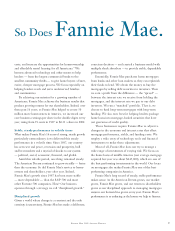Fannie Mae 2002 Annual Report Download - page 21
Download and view the complete annual report
Please find page 21 of the 2002 Fannie Mae annual report below. You can navigate through the pages in the report by either clicking on the pages listed below, or by using the keyword search tool below to find specific information within the annual report.
For more answers from Franklin D. Raines about our mission, our business, and
the future of homeownership in America, please visit “Answers from the CEO”
at www.fanniemae.com/CEOanswers
FANNIE MAE 2002 ANNUAL REPORT 19
mortgage options, and other tools
and services.
How does our American Dream
Commitment help our business to
grow? For Fannie Mae, focusing on
underserved Americans is more than
just the right thing to do, or some-
thing we do on the side. It is the
center of our business, and a secret
to our long record of steady business
growth — and double-digit increase
in core business earnings per share
— for the past 16 years. Focusing
on underserved families will help to
ensure our business will grow because
they represent a large, untapped,
and fast-growing housing market
in America.
Consider these facts:
•While 68 percent of Americans
own their homes, and 74 percent
of white families do, less than 50
percent of minority families are
homeowners. In 2002, President
George W. Bush challenged the
private sector to help create 5
million new minority homeowners
before the decade is over. In
response, Fannie Mae pledged to
provide $700 billion specifically
for minority families, and to lead
the market in serving African
American and Hispanic families.
•In 2001, an estimated 1.3 million
American home buyers — many
of them families of modest means
with blemished or non-traditional
credit histories — financed the
purchase of their home through
higher cost subprime mortgage
loans. Many of these families could
qualify for one of Fannie Mae’s
cheaper conventional rate
mortgages and potentially save
hundreds of dollars a month in
mortgage payments on the same
home. Our Expanded Approval
mortgage options offer lower-
income families a much better
deal on their mortgage, even if
they have imperfect credit.
•Over this decade, the projected
surge in immigration and
population is expected to create
13-15 million new households in
this country. Millions of families
who came to this country during
the 1990s will become homeowners
during this decade. Our initiative
to help immigrant families
attain homeownership includes,
for example, culturally sensitive
mortgage options and bilingual
marketing materials to help
lenders address the needs of
immigrant borrowers.
Thanks in large part to such strong
projected growth in the untapped,
underserved segments, Fannie Mae’s
business outlook is very strong.
At Fannie Mae, our business
growth rests on a simple proposition:
As we achieve our mission of
expanding homeownership, we grow
our business. As our business grows,
we can deliver better returns to our
shareholders. In that way, our mission
and business are not merely balanced
— they are in perfect alignment.
























